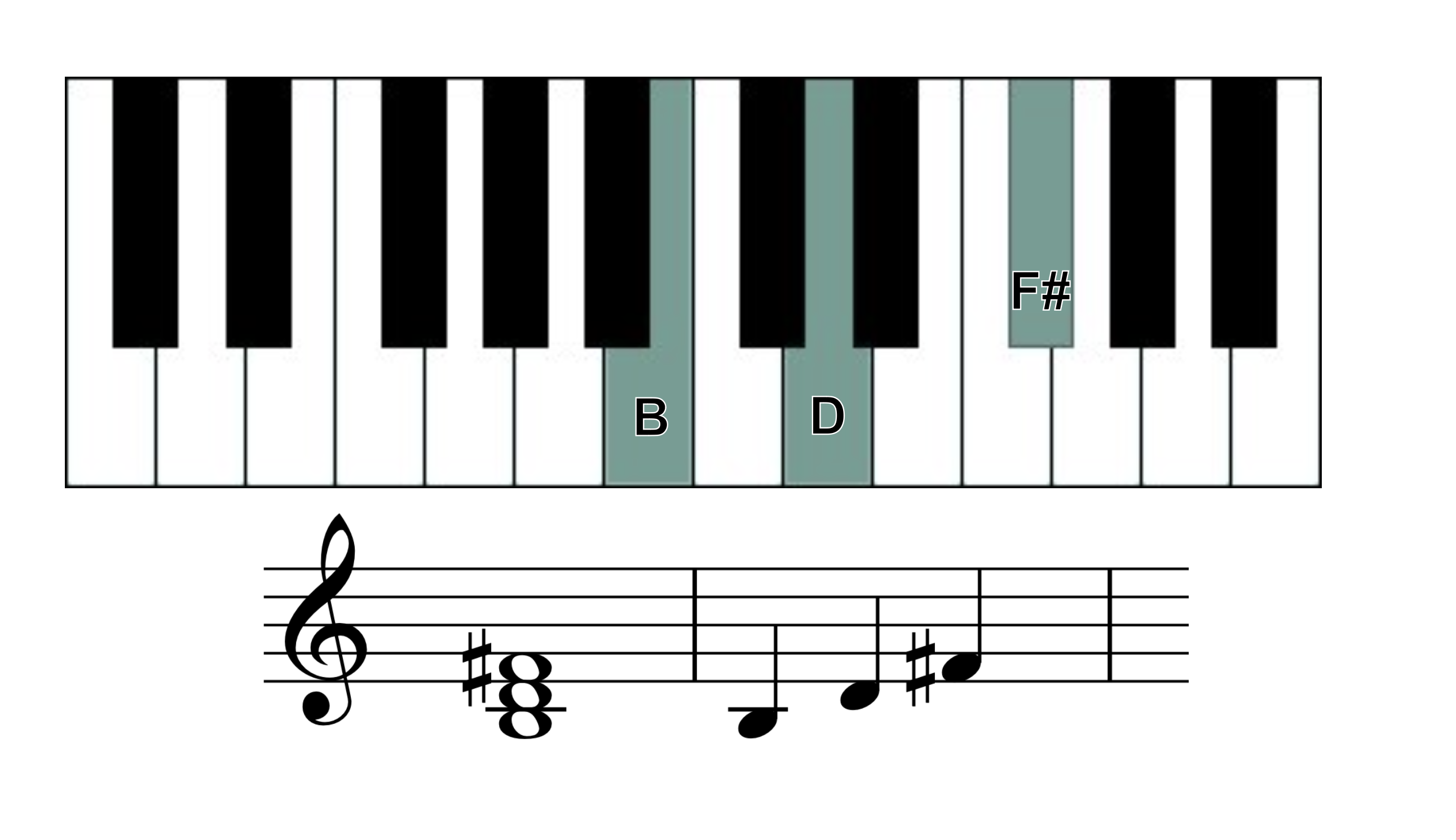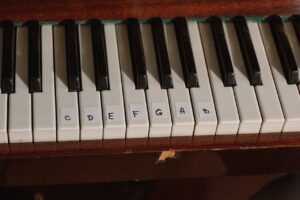To play the B minor chord, begin by locating the note B, which is just to the right of the group of three black keys. Once you’ve found it, combine B with D and F# to create the B minor chord.

B minor notes
The notes in a B minor chord piano are B, D, and F#.
The B minor chord notes are called: the root (B), third (D) and fifth(F#). Together, they create a slightly sad or emotional sound.
To play this chord in its root position (basic form) with your right hand, use these fingers:
- F# – Fifth finger (5)
- D – Third finger (3)
- B – Thumb (1)
For the left hand, use the following fingers:
- F# – Thumb (1)
- D – Third finger (3)
- B – Fifth finger (5)
The inversions of B minor chord
The inversions of the B minor chord piano are formed by rearranging the order the notes are played in. Chord inversions allows you to play the same chord with a different sound and control how you play each note of the chord.
The B minor chord has two inversions:
- B minor first inversion puts the B at the top of the chord leaving the D as the lowest note.
- B minor second inversion puts both the B and D at the top leaving the F# as the lowest note
Let’s break down these inversions further and discover how to play them on piano.
How to play B minor first inversion
To play the first inversion of the B minor piano chord, start with D as the lowest note. Next, play F# above it, and finally, add B as the highest note. This gives the chord a new sound that’s great for moving between other chords.

For the right hand, use these fingers:
- D – Thumb (1)
- F# – Middle finger (3)
- B – Fifth finger (5)
For the left hand, use these fingers:
- D – Fifth finger (5)
- F# – Third finger (3)
- B – Thumb (1)
How to play B minor second inversion
To play the second inversion of the B minor chord, start with F# as the lowest note. Then, play B above it, and finally add D as the highest note. This inversion gives the chord a different sound and is often used to make chord transitions smoother.

For the right hand, use these fingers:
- F# – Thumb (1)
- B – Middle finger (3)
- D – Fifth finger (5)
For the left hand, use these fingers:
- F# – Fifth finger (5)
- B – Third finger (3)
- D – Thumb (1)
B minor chord progression
The B minor chord progression is widely used in various genres, from rock and pop to jazz and classical music. A Bm chord progression often includes chords like Bm, D, A, and F#. Here are some popular B minor chord progressions:
- Bm – G – D – A
- Bm – A – G – F#
- Bm – F#m – G – Em
- Bm – G – A – F#
These progressions highlight the versatility of the B minor chord progression, offering a range of moods from somber to uplifting. They are a great way to put your knowledge of piano chords to the test. To understand these chord symbols and how to play them check out the Skoove’s tailor made beginner chord progression courses.
Piano chords generator
💡 If you are reading this from a mobile device, rotate it to display the tool in full width.
1. Click on “Chords”
2. Choose the “Root” of the chord
3. Choose the “Chord qualities” (major, minor, etc.)
4. Click “Display”
Popular songs to play with the Bm piano chords
In The Hall of the Mountain King – Edward Grieg
The song In The Hall of the Mountain King is a great example of music composed at a different time. It allows even beginners to use the versions of the easy B minor chord explained here, and provoke the same sense of grandeur playing a song that everyone knows. This is a simple and common chord progression in B minor.
Something Just Like this – Coldplay
Africa – Toto
Greensleeves – Traditional
An incredible song to play with B minor in, is the classic ballad Greensleeves. Here you will only play the chords in the left hand with two fingers, but the right hand will be playing the minor third of the chord.
The inversions happen throughout the song, and by putting the third of the chord in the right hand it allows the left hand to play perfect fifths, providing a deep and rich, open sound in your instrument.
This song is playable even by beginners, it can help you to understand relative majors and the circle of fifths.
Boys Don’t Cry – The Cure
Author of this blog post:
Susana Pérez Posada

With over seven years of piano education and a deep passion for music therapy, Susana brings a unique blend of expertise to Skoove. A graduate in Music Therapy from SRH Hochschule Heidelberg and an experienced classical pianist from Universidad EAFIT, she infuses her teaching with a holistic approach that transcends traditional piano lessons. Susana’s writings for Skoove combine her rich musical knowledge with engaging storytelling, enriching the learning experience for pianists of all levels. Away from the piano, she loves exploring new places and immersing herself in a good book, believing these diverse experiences enhance her creative teaching style.
Published by Lydia Ogn from the Skoove team














